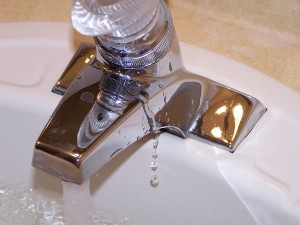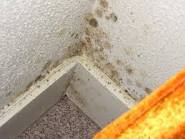Do You Have Water Woes?
When winter sets in, it can feel rather ironic when it’s raining outside and you can’t get your washing machine to fill with water. Or maybe you have an appliance providing you with an abundance of the wet stuff exactly where you don’t want it – like the kitchen sink or the floor. In this issue, we present the most common winter water problems we see and a few suggestions for troubleshooting.
 1) Why won’t my washing machine fill?
1) Why won’t my washing machine fill?
Washing your clothes used to be a simple, although labor intensive activity. These days washing machines are fairly complex appliances. When faced with figuring out what’s wrong, it might feel like you need a degree in engineering to figure out where the problem lies. It actually could be a simple solution, or not. Here’s how to find out:
Maybe someone turned off the water supply. Make sure the faucets are turned on. Or it might simply be a kink in one of the hoses. To check for a kink you’ll need to pull the washer out so you can see the hoses. If by straightening the hoses you get water…problem solved. Or it could be clogged water inlet filters. Since you have the machine pulled out already, unplug it and disconnect the hoses. The filters should be sitting where the hoses attach inside the machine. If they’re clogged, clean them out, reconnect your hoses and try again.
If that doesn’t work, it gets a bit more complicated. The water inlet valve could be broken or faulty. Failure to fill could also be the fault of the water level switch or the pressure chamber. (Whew!!) If that sounds complicated, it is! These problems should be tackled by a professional.
broken or faulty. Failure to fill could also be the fault of the water level switch or the pressure chamber. (Whew!!) If that sounds complicated, it is! These problems should be tackled by a professional.
2) Why is there standing water in my washer / dishwasher?”
As long as your toilets and showers are not also backing up, likely you can rule out needing to call the local “Trusty Rooter” company.
Let’s break down the trouble shooting by appliance.
In the washing machine, if there is water inside the machine after a cycle, it could be a clogged drain tube. To test this, remove the drain tube and see if you can blow air through it. If the line is clear, the problem is likely a faulty water pump, which is something a professional should repair. If water spills outside of the washer during a cycle, it could be a clogged drain. We don’t suggest you try to repair this yourself, but you will at least have an idea of what’s wrong and you can provide a more accurate assessment when you call for a repair.
 If your dishwasher isn’t draining, make sure your garbage disposal is clear and make sure the air gap is clean. A symptom of a dirty air-gap is water also flooding your counter. Just pop off the air-gap cover to see if it needs cleaning. If these are clear, it might be that the drain is clogged. Make a homemade solution of Vinegar and Baking Soda and pour it into the drain basket. Let settle for 15 minutes and pour in a pot of boiling water to see if that breaks up the clog. If not, it’s time to call in the professionals.
If your dishwasher isn’t draining, make sure your garbage disposal is clear and make sure the air gap is clean. A symptom of a dirty air-gap is water also flooding your counter. Just pop off the air-gap cover to see if it needs cleaning. If these are clear, it might be that the drain is clogged. Make a homemade solution of Vinegar and Baking Soda and pour it into the drain basket. Let settle for 15 minutes and pour in a pot of boiling water to see if that breaks up the clog. If not, it’s time to call in the professionals.
Sometimes the back-up isn’t just inside your washer. Sometimes the washer backs up into another place like the kitchen sink (lovely). This could be caused by a clogged drainage tube. Or if the dishwasher is backing up into the kitchen sink, it may be incorrectly installed.
When it comes to repairing problems involving appliances, plumbing, and water we’d like to suggest that this probably should not be a weekend do-it-yourself project. So, whether it’s inside or out, if you don’t have water where you want it, or you have too much where it’s not supposed to be, The Fix-It Professionals are here to help! Read on for our special – designed for just such an emergency! January Special just right for your needs!
?>And Now It’s Time to Play… … Where’s…That…Leak?
January 14, 2015 by
Filed under Blog
Brought to you by the good folks at Wood Rot, Mold and Wasted Water.
But seriously, leaks inside the home are at least annoying, and at most can be hazardous to your home and your health. So today we’re playing the game “Where’s That Leak” to help you discover how to find those drips, along with some information about why it’s so important. Along the way are some tips for fixing leaks, some resources where you can get additional information – and where you can get help!
And now it’s time for our first question.

A drippy faucet is caused by:
a) Faulty water pressure
b) Loose gaskets in the faucet
c) Failing washers in the handle
The correct answer is C. Most drips are due to old, failing washers in the handle assembly. If you’re feeling handy, the parts are quite inexpensive but the process requires some skill and a few precautions. Be sur
Once you’ve gathered what you need, turn off the water under the sink. If there is any water coming out of the faucet after you’ve turned the water off under the sink, you also have a leak at the valve and this will need to be replaced. You’ll need to further research how to make this repair as it will require shutting the main water off and different repair supplies. Sounds complicated doesn’t it? Stay with us until the end of the game for a practical solution.e that you have all of the tools you need before you start. Also make sure you completely understand the repair you’re attempting. You can search the internet for “how to” videos or instructions.
But now, on to Question Number 2
On average, how much water can a single leaky faucet waste?
a) About one gallon a week
b) About one gallon day
c) About one gallon a month
 The correct answer is B. The USGS website estimates that with just one drippy faucet dripping 10 times per minute, you would waste 347 gallons of water a year! And of course, if you have more than one drippy faucet, well that can be a lot of water. If you have leaky faucets and want to find how much water you might be wasting, you can go to the USGS website and use their handy estimator by clicking here.
The correct answer is B. The USGS website estimates that with just one drippy faucet dripping 10 times per minute, you would waste 347 gallons of water a year! And of course, if you have more than one drippy faucet, well that can be a lot of water. If you have leaky faucets and want to find how much water you might be wasting, you can go to the USGS website and use their handy estimator by clicking here.
Question Number 3
The area under your sink should be:
a) For storing every imaginable cleanser and gadget for your bathroom or kitchen
b) Used for storage, but kept well organized
c) Kept as clear as possible
The answer is C. When you use the area under your sink to store some or all of your supplies it becomes very difficult to determine if this area is damp. Dampness leads to all kinds of potential problems. Termites love damp dark places. Constant moisture can lead to rot, mold or even destroy the bottoms of any cans or canisters stored under the sink.
If that’s not enough to scare an ordinary person, think of all of the electrical connections that are under a typical kitchen sink – for the dishwasher, the garbage disposal etc. As you’re probably aware, water and electricity do not play nice together. Hiring a professional who understands both plumbing and the electrical aspect of repair would be a wise and safe choice should you discover a leak under the kitchen sink.
Mold is a health hazard which is encouraged to grow by:
a) Leaky plumbing
b) Improper ventilation of your bathroom
c) A leak in your roof or windows
d) All of the above
The correct answer is D. Mold affects indoor air quality. In 2004 the Institute of Medicine determined that there was sufficient evidence to link indoor exposure to mold to asthmatic symptoms, coughing, and wheezing in otherwise healthy people there was suggestive evidence linking indoor mold exposure to respiratory illness in otherwise healthy children. If that’s not enough to inspire you so stamp out the damp, the Institute of Medicine also found sufficient evidence to link just being exposed to damp indoor environments with the same or similar symptoms in adults and children. For more information about damp environments, mold and possible health effects you can visit their website by clicking here.
And now for our final Bonus Question:
When you discover that plumbing and/or electrical repairs need to be made at your home your best choice is: a) Do an internet search for “how to,” run to the hardware store for supplies, and “wing it.”
a) Do an internet search for “how to,” run to the hardware store for supplies, and “wing it.”
b) Call your brother “Bob” to come help you, because he fixed a sink once.
c) Hire someone who does this sort of thing for a living.
And the correct answer is C! The Fix-It Professionals are your best choice for tricky plumbing and electrical repairs.
How many answers did you get right? No matter what your score, you’re a winner, Congratulations! As your “play along at home prize” The Fix-It Professionals have a January Special just right for your needs! Read on to learn more.
Safety Wrap-Up for 2014
January 6, 2015 by
Filed under Blog
The presents are all opened and the delicious meals enjoyed. Now it’s time to look forward to a New Year’s celebration and 2015. Have you resolved to have a safe and prosperous new year? Here are a few ideas to help you wrap up 2014 safely, so you can look forward to a wonderful new year.
 Is Your Christmas Tree Crispy?
Is Your Christmas Tree Crispy?
If you have a fresh tree, no doubt it’s starting to get a little tired of being indoors. If you’re not ready to take it down just yet, run your hands along a few of the branches. If the tree feels dry or needles drop off, your lovely décor is now a fire hazard. Don’t take any chances! You should immediately remove the decorations and lights and set it outside for recycling.
Were Those Lights Supposed to be Flashing?
If any of your decorative lights were flickering or flashing and they weren’t supposed to, this would be a great time to replace them. Don’t put them away and figure that you’ll replace them next year. Trash them now. Besides, this is a terrific time to get those “post-holiday deals” on all things “Christmassy.”
Don’t Create a Tripping Hazard
Taking down the tree and all of those decorations can be lots of work. Don’t give in to the temptation to get the main job done and just stack the boxes until it’s “convenient to put them away.” The last thing you want as a reminder of the 2014 holiday season is a trip to the emergency room because you’ve tripped over a bunch of “stuff you meant to put away.”
Was Your Holiday Meal Experience Complete With “Unexpected Mood Lighting?”
It happens every year. When all of those kitchen appliances are running at the same time, a circuit breaker is bound to protest. If you had some unexpected darkness and/or dysfunctional kitchen areas during the holidays, an excellent time to get that fixed is now…while the memory of how much “fun” the experience was is fresh in your mind.
Or Maybe Santa Was Naughty When Santa is in a rush, all kinds of things can get broken. Maybe he was in too much of a hurry bringing in the presents and broke the door knob (oops), pulled loose the handrail (oh dear) or broke the handle on the toilet (yikes). Well, accidents happen, and perhaps during all the festivities you’ve just now noticed. This weekend might be a good time inspect for new problems and make those little repairs that will become annoyances later.
When Santa is in a rush, all kinds of things can get broken. Maybe he was in too much of a hurry bringing in the presents and broke the door knob (oops), pulled loose the handrail (oh dear) or broke the handle on the toilet (yikes). Well, accidents happen, and perhaps during all the festivities you’ve just now noticed. This weekend might be a good time inspect for new problems and make those little repairs that will become annoyances later.
Bonus Tip – Having Nothing to do With Home Maintenance:
December is that special time of the year when identity thieves and people who swipe credit card numbers are most active. Be sure to check your credit card and bank statements for unusual activity. Yes, this doesn’t have anything to do with home maintenance, but when a member of your family helps with financial matters, this kind of financial fiasco is something that we just have to mention.
If you’d like some help putting away decorations, finding the solution to why that circuit switch flipped, or if you’re ready to winterize your home now that it’s finally cold, just give us a call and take advantage of our December Special! We’re here to help!
?>
